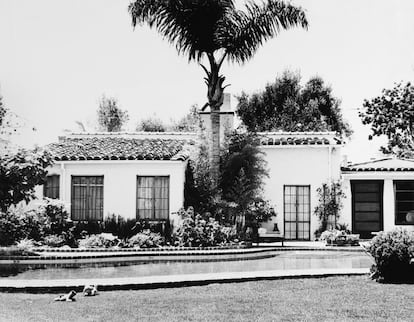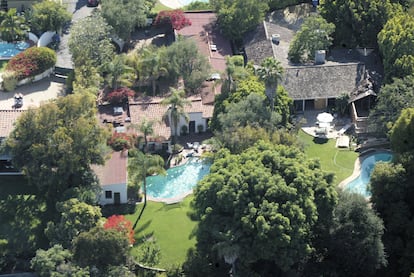Marilyn Monroe’s house will remain standing as the city of Los Angeles halts its demolition
A day after it became known that the star’s only former property was on the verge of disappearing, the city’s Department of City Planning prevents its demolition by nominating it for its list of potential historic buildings


Marilyn Monroe decided to call her house, the only one she ever owned, “Cursum Perficio”, which translates to “Here ends my journey.” And the journey of that home has very nearly come to an end. But 12305 Fifth Helena Drive will, after all, survive. At that address sits the only house that belonged to Marilyn Monroe. The movie star married three times, lived with her three husbands, spent time at the famous Roosevelt Hotel on Hollywood Boulevard, but it wasn’t until she turned 35 that she bought her first and only home. A small house, far from being called a mansion, of about 2,900 square foot (270 square meters) in the Brentwood hills, west of Los Angeles. A villa that after her death passed from one hand to another until now, when it has been about to be destroyed. Its new owners applied for a demolition permit last August, which was a mere formality, that is, they were going to be able to tear it down. But the news of this came out on Thursday and just 24 hours later it has been revealed that the demolition has been stopped.
As EL PAÍS has confirmed, indeed, the house cannot be demolished right now. This has been made known by the Los Angeles Department of City Planning. This Friday morning, the City Council voted to initiate the procedures that will nominate Monroe’s house as a Historic-Cultural Monument (HCM), which would incorporate it into a list of protected properties. In that list there are more than 1,200 buildings scattered throughout 35 areas of the city, more than 50 of them in Brentwood, but the actress’s house was not on the list. Now it will be, and that prevents it from being touched. The ordinance on Cultural Heritage is registered in an administrative code that indicates that the process is stopped, but not only to tear it down: It includes the suspension of the demolition and substantial modifications.
That is, the city prevents for now not only that the house be demolished, but also that any modification is done on the property, which in these 60 years since the death of the star has undergone certain changes, especially in the kitchen and bathrooms, and also when an annex building that was intended as a guest apartment was connected to the main residence. The nomination study comes first, but it may take up to six months for the city to make a decision on whether to consider (if it does, which everything indicates it will) the house as a Historic-Cultural Monument, and on how to protect it afterward.

According to the city, “now that the nomination has been initiated, Los Angeles City Planning Office of Historic Resources staff will prepare the nomination. From the time of the initiation, the Cultural Heritage Commission has 75 days to review the nomination and make a recommendation to the City Council. The City Council then has 90 days to act on the nomination. The owner can request time extensions if needed”.
In 2013 there was already a first attempt to consider the villa, of Spanish or colonial style, as part of the historical heritage of the city, as confirmed to this newspaper by the Department of City Planning. Its technicians went to inspect the place and even issued a small public report where they talked about its possible inclusion in the HCM list. But as the house was private property, and they could not access it, only see it from the outside, like so many other tourists who walk there every day, they did not reach a definite conclusion. It is unknown how the city will now find out its condition, since the house is still in private hands. The marriage formed by Dan Lukas and Anne Jarmain, owners of an investment fund, took it over in 2017 and sold it this August.
Monroe bought the house in 1962 for $77,500, which adjusted for inflation would mean almost $760,000 today, and it already had a certain historical value, since it was built in 1929. It has handmade tiles (on them read, precisely, that inscription, “Cursum Perficio”), vaulted wooden ceilings with exposed beams, terracotta floors and a pool in which, according to Hollywood urban legends, the star never got to bathe. She decorated it with care, with many handicrafts brought from Mexico, although she never completed it and, at her death, closed boxes remained in the corridors. A year after her death, it passed into the hands of a married couple, Gilbert and Betty J. Nunez, who also took possession of many of the personal belongings accumulated by the actress, which they auctioned decades later.

So far, its owners had respected the place. The house is far from being like today’s distant, armored celebrity mansions in the Hollywood Hills. It is a relatively simple place, in an affluent neighborhood but far from the glamour of Bel Air or the total isolation of Calabasas. In fact, the Brentwood neighborhood homeowners association lamented the news of its demolition to this newspaper on Thursday. “We were very sad to hear of the home’s pending demolition, especially since it may very well be one of the most famous homes in the world!” expressed Rodney Liber, former movie producer and resident of the area for 30 years. “However, the BHA does not have rights or jurisdiction to intercede as there are no rules about obtaining a permit from the City and the home is NOT on the historical society list. We had hoped the current owners had purchased it for preservation, but may have changed their minds due to the value of the land”. However, their opinion now opposes that of the powerful Los Angeles city council, which has opened its eyes at the last moment to safeguard a piece of the immense and sadly decaying architectural and cultural heritage of its golden era. For the moment, this is not the end of his journey.
Sign up for our weekly newsletter to get more English-language news coverage from EL PAÍS USA Edition
Tu suscripción se está usando en otro dispositivo
¿Quieres añadir otro usuario a tu suscripción?
Si continúas leyendo en este dispositivo, no se podrá leer en el otro.
FlechaTu suscripción se está usando en otro dispositivo y solo puedes acceder a EL PAÍS desde un dispositivo a la vez.
Si quieres compartir tu cuenta, cambia tu suscripción a la modalidad Premium, así podrás añadir otro usuario. Cada uno accederá con su propia cuenta de email, lo que os permitirá personalizar vuestra experiencia en EL PAÍS.
¿Tienes una suscripción de empresa? Accede aquí para contratar más cuentas.
En el caso de no saber quién está usando tu cuenta, te recomendamos cambiar tu contraseña aquí.
Si decides continuar compartiendo tu cuenta, este mensaje se mostrará en tu dispositivo y en el de la otra persona que está usando tu cuenta de forma indefinida, afectando a tu experiencia de lectura. Puedes consultar aquí los términos y condiciones de la suscripción digital.
More information
Archived In
Últimas noticias
Maduro pleads not guilty before the federal court in New York: ‘I am still the president of Venezuela’
A new test can detect Alzheimer’s from a finger prick
UN team enters Sudanese city of El Fasher after paramilitary massacre: ‘It’s like a ghost town’
A recipe for resistance: Indigenous peoples politicize their struggles from the kitchen
Most viewed
- Gilles Lipovetsky: ‘If you want to live better and fall in love, take Prozac, don’t look to philosophy’
- Alain Aspect, Nobel laureate in physics: ‘Einstein was so smart that he would have had to recognize quantum entanglement’
- Alvin Hellerstein, a 92-year-old judge appointed by Bill Clinton, to preside over Maduro’s trial in New York
- Why oil has been at the center of Venezuela-US conflicts for decades
- Cuba confirms death of 32 of its citizens in the US attack against Venezuela










































